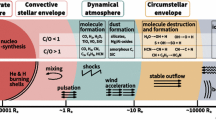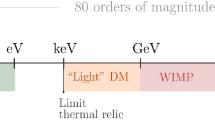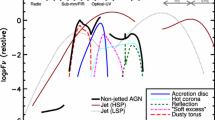Abstract
AN apparent absence, or deficiency, of white dwarfs fainter than ∼10−4L⊙ has been noticed for a long time1. Often attributed to incomplete statistics for the coolest, faintest objects2,3, this deficiency has nevertheless not been removed even after the most persistent spectroscopic surveys by Greenstein4,5 (see also Liebert6). Moreover, Jones's7 analysis of reduced proper motions for the very faint proper-motion stars observed by Eggen and by Luyten tends only to confirm the deficiency. If real, the lack of very faint white dwarfs may have its origin in a rapid drop of the internal heat content of the white dwarf as a result of ion crystallisation and of envelope convection when the star becomes sufficiently cool (see Greenstein4 and Van Horn8 and references therein). But perhaps it will eventually prove to be difficult, as Lamb and Van Horn9 have already found, to increase the cooling rate by a sufficiently large amount to account for all the deficiency. Another explanation is proposed here on the basis of Dirac's10–12 cosmological hypothesis that the gravitational constant, G, varies with the elapsed time since the beginning of the expansion of the Universe as t−1 and the number of particles in the Universe increases as t2 (if the measurements are made in atomic units). For a white dwarf, the Chandrasekhar mass limit is a collection of fundamental constants proportional to G−3/2, and therefore increases with time as t3/2. In the ‘additive’ version of Dirac's theory, the actual mass, M, of a relatively small object like a star remains essentially unchanged by the creation of new matter in the Universe, and so a white dwarf becomes ‘more stable’ as time goes on. But, in the ‘multiplicative’ version of his theory, M increases as t2 and may eventually exceed the Chandrasekhar limit. If so, gravitational collapse of the white dwarf into an invisible black hole or neutron star will quickly ensue. Since some possible empirical support has already been adduced for the multiplicative theory, although not for the additive theory13–17, it is interesting to determine whether the multiplicative theory may also have something to do with the apparent deficiency of faint white dwarfs and whether there are any possible consequences for galactic evolution.
Similar content being viewed by others
References
Eggen, O. J., and Greenstein, J. L., Astrophys. J., 141, 83 (1965).
Weidemann, V., Z. Astrophys., 67, 286 (1967).
Hintzen, P., and Strittmatter, P. A., Astrophys. J. Lett., 193, L111 (1974).
Greenstein, J. L., Comm. Astrophys. Space Phys., 1, 62 (1969).
Greenstein, J. L., in White Dwarfs (edit. by Luyten, W. J.), 46 (Reidel, Dordrecht, 1971).
Liebert, J., Astrophys. J. Lett., 200, L95 (1975).
Jones, E. M., Astrophys. J., 177, 245 (1970).
Van Horn, H. M., in White Dwarfs (edit. by Luyten, W. J.), 97 (Reidel, Dordrecht, 1971).
Lamb, D. Q., and Van Horn, H. M., Astrophys. J., 200, 306 (1975).
Dirac, P. A. M., Nature, 139, 323 (1937).
Dirac, P. A. M., Proc. R. Soc., A 165, 199 (1938).
Dirac, P. A. M., Proc. R. Soc., A 338, 439 (1974).
Teller, E., Phys. Rev., 73, 801 (1948).
Pochoda, P., and Schwarzschild, M., Astrophys. J., 139, 587 (1964).
Gamow, G., Proc. natn. Acad. Sci. U.S.A., 57, 187 (1967).
Van Flandern, T. C., Mon. Not. R. astr. Soc., 170, 333 (1975).
Chin, C.-w., and Stothers, R., Nature, 254, 206 (1975).
Chandrasekhar, S., An Introduction to the Study of Stellar Structure (University of Chicago Press, Chicago, 1939).
Sandage, A., Q. Jl R. astr. Soc., 13, 282 (1972).
Mestel, L., Mon. Not. R. astr. Soc. 112, 583 (1952).
Schwarzschild, M., Structure and Evolution of the Stars (Princeton University Press, Princeton, 1958).
Chandrasekhar, S., Nature, 139, 757 (1937).
Salpeter, E. E., in Perspectives in Modern Physics (edit. by Marshak, R.), 463 (Interscience, New York, 1966).
Eggen, O. J., Observatory, 79, 135 (1959).
Eggen, O. J., Lynden-Bell, D., and Sandage, A. R., Astrophys. J., 136, 748 (1962).
Schönberg, M., and Chandrasekhar, S., Astrophys. J., 96, 161 (1942).
Author information
Authors and Affiliations
Rights and permissions
About this article
Cite this article
STOTHERS, R. White dwarfs, the Galaxy and Dirac's cosmology. Nature 262, 477–479 (1976). https://doi.org/10.1038/262477a0
Received:
Accepted:
Issue Date:
DOI: https://doi.org/10.1038/262477a0
- Springer Nature Limited





